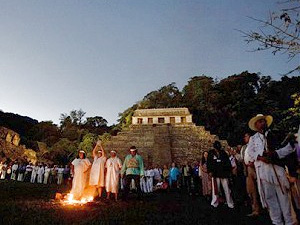
|
 |
 |
 Entertainment | May 2008 Entertainment | May 2008  
Real-life Skull Worship Inspires New 'Indy' Film
 Mark Stevenson - Associated Press Mark Stevenson - Associated Press
go to original


| | People watch as Mayan indian priests participate in a ceremony while one holds up a crystal skull at the Mayan ruins of Palenque, Mexico. (Associated Press) | | |
Palenque, Chiapas - There is a legend that the ancient Maya possessed 13 crystal skulls which, when united, hold the power of saving the Earth — a tale so strange and fantastic that it inspired the latest Indiana Jones movie.

Experts dismiss the hundreds of existing crystal skulls as fakes that were probably made by colorful antiquities traders in the 19th century. But Mayan priests worship the skulls, even today, and real-life skull hunters still search for them.

The true story of the skulls stretches over continents and hundreds of years, and may be even more extraordinary than the tale portrayed in this fourth installment of the Harrison Ford franchise.

It's unclear what version of the tale will appear in "Indiana Jones and the Kingdom of the Crystal Skull," which opens in U.S. theaters on May 22.

The plot of the film — the first Indiana Jones movie since "The Last Crusade" came out in 1989 — revolves around a race against the Soviets to find the skulls.

Pre-release publicity from Paramount Pictures, the film's distributor, mentions the legend of the 13 skulls.

While much of the film's action occurs in Peru, the Paramount release also mentions a skull purportedly found at a Mayan ruin in 1924. Known as "The Skull of Doom," its provenance cannot be proved.

In fact, few of today's crystal skulls can be documented any further back than the 1860s, when Europe was swept by a rage for pre-Hispanic "relics." Frenchman Eugene Boban, a colorful antiquities dealer with a checkered past and murky political ties, set up a store here to supply the trade after the French invaded Mexico. Eventually he carted skulls around between New York, Paris and Mexico City, selling them to private collectors.

Buyers were often told that the skulls were made by the Mayas, whose civilization peaked between 300 and 900 A.D. But no crystal skull has ever been excavated from a documented archaeological site.

Some believe the skulls can emit and focus light, project visions and even influence terrestrial forces. Today, these beliefs persist in the jungles of southern Mexico among the Lacandon, the last unassimilated Mayas, some of whom still worship the skulls.

In the shadow of the Palenque ruins, Lacandon priest K'in Garcia fans copal incense and holds a heavy crystal skull above his head during ceremonies for Hacha'kyum, the Mayan god of creation.

Garcia, son of the Lancandon's most respected elder, Chan Kin, believes the skull has special powers, including the ability to stave off sickness and deforestation in the rain forest where the last Lacandon still live.

"When I am alone at night, at about 2 a.m., it starts to glow, it emits light, and it stays like that for about a minute," said Garcia.

Garcia says the skull was given to him by a local man — and while he believes it is very old, he doesn't know where it came from.

Thousands of miles away in Washington, Jane MacLaren Walsh keeps one of the skulls in her office at the Smithsonian Institution. She doubts the ancient Mayans ever had any such skulls.

An anthropologist and antiquities sleuth, she has spent more than a decade studying the best-known skulls, like the ones acquired by the British Museum and Paris' Quai Branly museum over a century ago, as well as the Smithsonian's own skull.

She says they are stylistically unlike pre-Hispanic depictions of death's heads, and often show microscopic marks from cutting tools unavailable in pre-Hispanic times.

"None of them is ancient," Walsh said. About the purported powers, she notes wryly: "I've been sitting in fairly close proximity to one of the skulls for about 16 years, and I have not witnessed anything like what people say."

The British Museum keeps a skull in its collections largely as a curiosity, listing its provenance as "probably European, 19th century."

It's possible that the near-human sized fakes may have been inspired by two real crystal skulls now on display at Mexico City's respected National Anthropology Museum. Much smaller and less perfectly carved than the ones held at the museums in Europe, these jewelry-sized trinkets, about an inch in height, are in the Aztec and Oaxaca collections, where the museum classifies them as either late pre-Hispanic or early colonial.

The skulls' legend has spawned a new breed of followers.

New-agers have associated the skulls with the belief that the Mayan "Long Count" calendar runs out on Dec. 21, 2012, when it reaches the end of a 5,126-year cycle. According to this theory, all 13 skulls must be reunited and lined up together to prevent the world from falling off its axis.

"I personally feel that (the skulls) are coming out now because humanity needs the information, their energy and they have probably their own purpose why they're coming out: to help us to create world peace," said Joshua "Illinois" Shapiro, 53, a self-described Crystal Skull Explorer who makes a living touring and giving lectures.

Shapiro has traveled the world seeking out skulls, and believes they link us to knowledge of past worlds like the Mayas, the lost civilization of Atlantis, or even extraterrestrials.

"I was wearing the Indiana Jones hat for a very long time," he claims, "far before they ever thought about putting a crystal skull in an Indiana Jones movie." | 
 | |
 |



